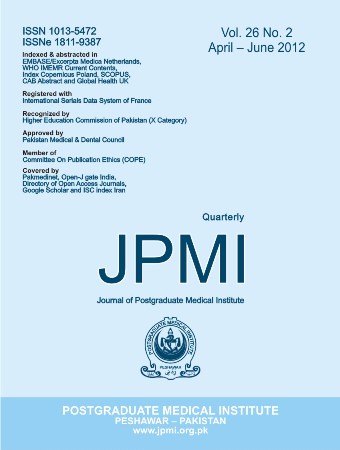TRENDS IN PATTERNS OF RESISTANCE AMONG MICRO ORGANISMS CAUSING NEONATAL SEPSIS IN PESHAWAR
Main Article Content
Abstract
Objective: To report the spectrum and patterns of resistance among micro organisms causing neonatalsepsis in a tertiary care neonatal setting.
Methodology: This descriptive study was conducted in Special Care Baby Unit (SCBU) Department ofChild Health and Microbiology Section Department of Pathology, Khyber Teaching Hospital Peshawarfrom March 2008 to January 2009. 1000 Blood cultures were taken, using standard methods, from neonateswith a clinical diagnosis of sepsis. The cultures were incubated and sensitivity to various antibiotics wastested by standard disc diffusion Technique.
Result: The culture positivity rate was 11.1%. E. coli was the most common organism found in 44(39.63%) cases, followed by Klebsiella (n= 21 18.91%), Staph aures (n=18, 16.21%), Staph Epidermises(n=16, 14.41%), Pseudomonas (n=12, 10.81%). None of the cultures was positive for Group BStreptococcus (GBS) and Listeria. Among the isolates there was low sensitivity (+) to ampicillin, goodsensitivity (++) to cefotaxime, ceftriaxone, ceftazidime, and maximum sensitivity (+++) to amikacin,quinolones and imipenem. Majority of the organisms were resistant to commonly used antibiotics.
Conclusion: Gram negative organisms remain the major cause of neonatal sepsis in tertiary care units.Majority of these organisms are resistant to commonly used antibiotics.
Article Details
Work published in JPMI is licensed under a
Creative Commons Attribution-NonCommercial 2.0 Generic License.
Authors are permitted and encouraged to post their work online (e.g., in institutional repositories or on their website) prior to and during the submission process, as it can lead to productive exchanges, as well as earlier and greater citation of published work.


